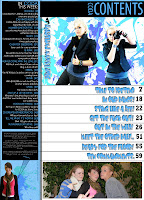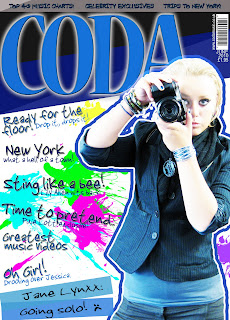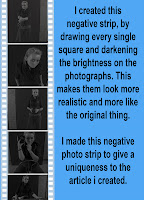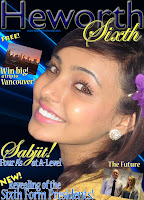n what way does your media product use, develop or challenge forms and conventions of real media products?
In the preparation of my media product - which was to create a music magazine front cover, contents page and an article, all based on the Indie music genre, I had to guarantee my final product realistic so it would be able to sit on the shelves alongside other major monthly magazines. Consequently I carried out some research of other products and into my potential target audience, 15-25 year olds. My main target audience is female, but I would like to appeal to males too.
 I aimed the cover at both sexes. I did this by having a conventionally ‘sexy’ posed female model as the cover girl, yet I kept the colour scheme to cool blue tones, which are stereotypically masculine - the colour scheme was retained throughout the magazine which gives the unique magazine its own house style, just like ‘Blender’ (2008) often keeps its layouts practically the same, with a very large image of the model in the centre of the page and little hooks around it. Having the same colour scheme throughout the magazine gives it its own house style
I aimed the cover at both sexes. I did this by having a conventionally ‘sexy’ posed female model as the cover girl, yet I kept the colour scheme to cool blue tones, which are stereotypically masculine - the colour scheme was retained throughout the magazine which gives the unique magazine its own house style, just like ‘Blender’ (2008) often keeps its layouts practically the same, with a very large image of the model in the centre of the page and little hooks around it. Having the same colour scheme throughout the magazine gives it its own house style  and makes it more recognisable, so that when the reader goes to buy a magazine, they just need to look for the blue colour scheme of the magazine I’ve produced and their brain automatically tells them it’s the norm.
and makes it more recognisable, so that when the reader goes to buy a magazine, they just need to look for the blue colour scheme of the magazine I’ve produced and their brain automatically tells them it’s the norm.
Furthermore, having all the text justified and in a specific layout helps the audience just look at exact areas on the page, such as ‘big quotes’, bold writing, the font type, the font size and the story hooks used, often used in ‘Q’ magazines. I broke this convention by placing them all down the left hand side of the cover. I used an asymmetrical cover layout. These all help the naked eye focus on that area where the magazine has emphasised to draw in attention. On the cover the story hooks aren’t straight, but are justified to the left hand side of the cover. Using bold writing for the story hooks emphasises them so that the reader spots the catchy hooks without delay. I justified the layout of the cover so that the image of the model was in front of the title. I did this because people are meant to know the name of the magazine whether or not it is partially covered or not. Magazines such as Blender (2007), NME (2009) and Vibe (2007) use this convention.
by placing them all down the left hand side of the cover. I used an asymmetrical cover layout. These all help the naked eye focus on that area where the magazine has emphasised to draw in attention. On the cover the story hooks aren’t straight, but are justified to the left hand side of the cover. Using bold writing for the story hooks emphasises them so that the reader spots the catchy hooks without delay. I justified the layout of the cover so that the image of the model was in front of the title. I did this because people are meant to know the name of the magazine whether or not it is partially covered or not. Magazines such as Blender (2007), NME (2009) and Vibe (2007) use this convention.
The barcode, the price and the date of the issue are all based on front cover conventions too. Using a ‘regular’ price of £1.95 was chosen by the niche market audience. They chose this cost through the questionnaire I handed out, and they thought that £1.95 was the perfect, yet, regular price to pay for a magazine of this type.
(https://blogger.googleusercontent.com/img/b/R29vZ2xl/AVvXsEjJ6c6VQm0FSAkw0XLS6DOB0k29__hfpFfXwUZq_OBq7ruksSH3MaKVTom8sohebP2HpwY-xWE9GYzuc0PYdH3i_JHn69iG4I8GTpOiMpod4UxEtI41wGOH_kNY2HJmKsnc9SRNBhlE4cs/s320/NME-contents+page.jpg).
.jpg)
I kept to the colour scheme and typical conventions of a magazine’s contents page, yet made it my own. I did this was by using a layout that was simple yet unique; I also used new images of Josie (the cover girl model) in the same clothes, just so she wasn’t in the same pose on the contents too. I used columns on the contents which almost every magazine uses, whether it is one, two or three. I have the magazine website on the contents page too, which is common in the age of web 2.0 for magazines to have a website so readers can interact with the publication, which gives the magazines more reputation, if people ever wanted to go on the website. I added an editor’s message to the contents page, to let the reader know a little more about the magazine – this is something I’ve seen in other magazines like ‘Uncut’.
 The justification of the text is aligned to the right hand side. In the main article section of the contents page, a funkier writing font is used - ‘Baby Kruffy’ - this is to grab the readers attention as it is cooler than the normal ‘Century Gothic’ used on the left hand side of the page, which is used to list the smaller stories inside the magazine.
The justification of the text is aligned to the right hand side. In the main article section of the contents page, a funkier writing font is used - ‘Baby Kruffy’ - this is to grab the readers attention as it is cooler than the normal ‘Century Gothic’ used on the left hand side of the page, which is used to list the smaller stories inside the magazine.I also found in magazines such as Blender (Aug 2007) the cover girl featured in the main article of the magazine., so, I used my cover girl as the main feature article too, to stick with the common convention in a magazine. The article I created could be seen as quite inspirational as it is based on an up and coming celebrity who has had to chose her security and her welfare over her new found career as a lead singer in a newly famous indie band, which is becoming the new genre in the charts today. This acknowledges a heroine-like character and shows ‘Jane Lynxx’ in a positive light. Although my article is sympathetic and world encourage my readers to aspire to be like her, it shows some of the pitfalls of fame.
Bauer media publishes worldwide, with an approximate empire 282 magazines in about 15 countries. They work closely with their customers to develop new solutions which make a difference within their business, just like I have by using a questionnaire to find out the customers needs and then acted upon it. (http://www.bauer.co.uk/aboutbauer) I would be widening the market for them, which will offer them an opportunity to expand their audience into a new market of 15 – 25 year olds. With Bauer I would be widening their portfolio. Also publishers from other retail magazines such as Blender’s:
Dennis Publishing (http://www.dennis.co.uk/dennis_site/about/dennisgroup.php) I’m sure would publish my magazine. As I am sure my media product would get far in the
Name: Sophie Handy
Age: 17
Occupation: Full-time student.
Why would she read this product: I sense my music magazine would hit an audience of the upper teenage working class population, interested in the latest music. I am aiming largely at a female target audience – but I hope by my colour scheme and the fact that the males are more likely to be interested in this sort of music and backgrounds – that it will appeal to males too. Someone with an office job would buy this magazine against others on the shelves, maybe with an interest in chart music and attends the latest gigs around the country. Someone with a peaceful night time, time to chill or relax and read a magazine – like the one I have produced, and a lot of spare time on his hands, other than the time spent at the latest music band gigs and at his job. Maybe even a fit and active man, around the age of 20-25.
When planning how to create a typical, modern music magazine, I had to find out what
 the target audience wanted.
the target audience wanted.Another theory I exploit is Uses and Gratifications. This suggests that the audiences actively use media products and magazines to meet some of the needs identified. Magazines may be used by the audience to compensate for the lack of self-esteem or social success, as an example of the girls’ teenage lifestyle magazines, which address the audience as a ‘best friend’ rather than an authority figure.
Magazines always exploit the theory of uses and gratifications because the target audiences they’re aiming to gain, will identify (though most of the time its wishful thinking) with the lifestyle it promotes. Marjorie Fergusons theory (1980) identified four types of facial expression in the covers of magazines found on the shops shelves today. I think his theorem best covers my magazines stylistic features due to the fact my model isn’t sexually posed, but looks quite invitational. http://lauraarobinsonn.blogspot.com/2009/11/majorie-fergusons-theory.html
.jpg)
McQuail, Blumler and Brown (1972) defined four major areas of need which the media in general seek to gratify, including:
- Personal Identity – people can relate to my cover story, and will buy it because they feel some sense of belonging because the magazine involves them by featuring a genre of music they feel important to them.
- Surveillance – people can use my magazine to retrieve information about topics they’re interested in. Like from a contents page.
Also Davis et al. and Julianne Dickey convey how they take the traditional stance that images of women are dominated by the male gaze – the masculine view of female beauty – and the female form is objectified for the male pleasure, giving a very narrow definition of femininity. Such theorists are also critical of the media industry being run by the masculine view. For example: most photographers are male – and I went along with this convention of using an attractive model, but tried to empower her by posing her photographing those ‘gazing’ at her.
I enjoyed using the digital camera and the tripod as I experimented with diverse camera shots, such as – medium shot, medium close up, and long shot – and angles, such as low angle and high angle, to show social class and superiority.
To cut out the image of the model on my front cover from the background she was on, I
 used the normal lasso tool which helps by clicking specific points around an image. Photoshop will draw straight lines from point to point as you continue to click on the canvas. I then used ‘Delete’ to undo a point and try again. This tool is not ideal for cutting out really difficult images, but is good for accuracy as you click where you want cut out.
used the normal lasso tool which helps by clicking specific points around an image. Photoshop will draw straight lines from point to point as you continue to click on the canvas. I then used ‘Delete’ to undo a point and try again. This tool is not ideal for cutting out really difficult images, but is good for accuracy as you click where you want cut out. I made a negative strip from scratch. I drew out every single square around the edge of the negative strip by using the square shape tool. I then drew the background as a bigger box than the images then placed all the little white squares around the edge, to make it look like a negative strip from a photo shoot. Furthermore, I added in the images and made them all the same size so it didn't look odd. However, I changed the brightness of the photographs and the saturation so the images where dark and black and white. I did this to make it look like they were negatives from a camera. Then, I fixed all the layers together so the piece was a whole, and then could move everything around as one layer, rather than 70 little ones.
I made a negative strip from scratch. I drew out every single square around the edge of the negative strip by using the square shape tool. I then drew the background as a bigger box than the images then placed all the little white squares around the edge, to make it look like a negative strip from a photo shoot. Furthermore, I added in the images and made them all the same size so it didn't look odd. However, I changed the brightness of the photographs and the saturation so the images where dark and black and white. I did this to make it look like they were negatives from a camera. Then, I fixed all the layers together so the piece was a whole, and then could move everything around as one layer, rather than 70 little ones.On the cover, I used a splatter brush to create the ‘ink print’ marks on the background, I downloaded this brush off of the internet; I used the technique/process of whitening the hair of the model and her skin by using the dodge tool.
The blog I created allowed me to take advantage of web 2.0 to become a producer of a media artefact with an internet audience of millions who can comment and post about my work. I combined text and images to explain the ideas and processes behind my magazine which can be found on my blog. Using the blog meant that I can layout our plans and show my annotations and it can be viewed by the public, who can provide feedback.
Looking back at my amateur preliminary task I feel that I’ve progressed a lot. My imagination, publishing and photography skills have improved and I have a much deeper
 understanding of how to produce a professional product on Adobe Photoshop for a selected genre, age range and target audience. I also feel confident in representing my views about design. I also can see the difference in professionalism between the two products and I can now see how I could have made the preliminary product better by gaining some more knowledge or practise on Photoshop. My research skills have advanced, as I analysed magazines and understood the conventions they used to attract their target audience, like specific colours, fonts and models to communicate a particular message to them. I have understood the importance of audience research by creating a questionnaire and this helped me find their needs, so, I could accurately target my magazine to meet the audience’s needs and produce one that could compete on the shelves ‘NME’. From my study of other music magazines and their conventions, I learned that a magazine should not be too busy, as when there is too much to look at it takes the attention away from the main purpose of the magazine, which is for a reader to actually look inside, yet it should be attractive and eye-catching enough to stand out from the crowd of the mass of other music magazines that are on the shelves today.
understanding of how to produce a professional product on Adobe Photoshop for a selected genre, age range and target audience. I also feel confident in representing my views about design. I also can see the difference in professionalism between the two products and I can now see how I could have made the preliminary product better by gaining some more knowledge or practise on Photoshop. My research skills have advanced, as I analysed magazines and understood the conventions they used to attract their target audience, like specific colours, fonts and models to communicate a particular message to them. I have understood the importance of audience research by creating a questionnaire and this helped me find their needs, so, I could accurately target my magazine to meet the audience’s needs and produce one that could compete on the shelves ‘NME’. From my study of other music magazines and their conventions, I learned that a magazine should not be too busy, as when there is too much to look at it takes the attention away from the main purpose of the magazine, which is for a reader to actually look inside, yet it should be attractive and eye-catching enough to stand out from the crowd of the mass of other music magazines that are on the shelves today.  Furthermore, my knowledge of writing in a journalistic style has improved and I’ve very much enjoyed the challenge of completing my production of a ‘real media artefact’ for a deadline. I’ve moved on from producing pages for a magazine with an extremely localised niche audience to planning, researching and producing a magazine aimed at a wider – national – niche audience that can compete in the market with existing products such as ‘NME’, ‘Blender’ and ‘Vibe’.
Furthermore, my knowledge of writing in a journalistic style has improved and I’ve very much enjoyed the challenge of completing my production of a ‘real media artefact’ for a deadline. I’ve moved on from producing pages for a magazine with an extremely localised niche audience to planning, researching and producing a magazine aimed at a wider – national – niche audience that can compete in the market with existing products such as ‘NME’, ‘Blender’ and ‘Vibe’.


No comments:
Post a Comment